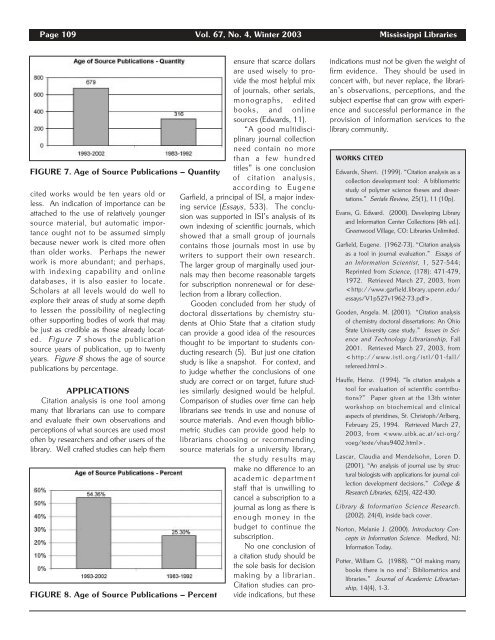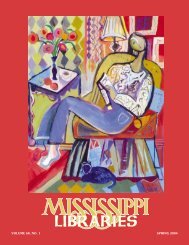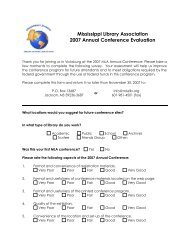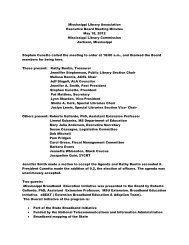Full Text (PDF) - Mississippi Library Association
Full Text (PDF) - Mississippi Library Association
Full Text (PDF) - Mississippi Library Association
You also want an ePaper? Increase the reach of your titles
YUMPU automatically turns print PDFs into web optimized ePapers that Google loves.
Page 109 Vol. 67, No. 4, Winter 2003 <strong>Mississippi</strong> Libraries<br />
FIGURE 7. Age of Source Publications – Quantity<br />
cited works would be ten years old or<br />
less. An indication of importance can be<br />
attached to the use of relatively younger<br />
source material, but automatic importance<br />
ought not to be assumed simply<br />
because newer work is cited more often<br />
than older works. Perhaps the newer<br />
work is more abundant; and perhaps,<br />
with indexing capability and online<br />
databases, it is also easier to locate.<br />
Scholars at all levels would do well to<br />
explore their areas of study at some depth<br />
to lessen the possibility of neglecting<br />
other supporting bodies of work that may<br />
be just as credible as those already located.<br />
Figure 7 shows the publication<br />
source years of publication, up to twenty<br />
years. Figure 8 shows the age of source<br />
publications by percentage.<br />
APPLICATIONS<br />
Citation analysis is one tool among<br />
many that librarians can use to compare<br />
and evaluate their own observations and<br />
perceptions of what sources are used most<br />
often by researchers and other users of the<br />
library. Well crafted studies can help them<br />
FIGURE 8. Age of Source Publications – Percent<br />
ensure that scarce dollars<br />
are used wisely to provide<br />
the most helpful mix<br />
of journals, other serials,<br />
monographs, edited<br />
books, and online<br />
sources (Edwards, 11).<br />
“A good multidisciplinary<br />
journal collection<br />
need contain no more<br />
than a few hundred<br />
titles” is one conclusion<br />
of citation analysis,<br />
according to Eugene<br />
Garfield, a principal of ISI, a major indexing<br />
service (Essays, 533). The conclusion<br />
was supported in ISI’s analysis of its<br />
own indexing of scientific journals, which<br />
showed that a small group of journals<br />
contains those journals most in use by<br />
writers to support their own research.<br />
The larger group of marginally used journals<br />
may then become reasonable targets<br />
for subscription nonrenewal or for deselection<br />
from a library collection.<br />
Gooden concluded from her study of<br />
doctoral dissertations by chemistry students<br />
at Ohio State that a citation study<br />
can provide a good idea of the resources<br />
thought to be important to students conducting<br />
research (5). But just one citation<br />
study is like a snapshot. For context, and<br />
to judge whether the conclusions of one<br />
study are correct or on target, future studies<br />
similarly designed would be helpful.<br />
Comparison of studies over time can help<br />
librarians see trends in use and nonuse of<br />
source materials. And even though bibliometric<br />
studies can provide good help to<br />
librarians choosing or recommending<br />
source materials for a university library,<br />
the study results may<br />
make no difference to an<br />
academic department<br />
staff that is unwilling to<br />
cancel a subscription to a<br />
journal as long as there is<br />
enough money in the<br />
budget to continue the<br />
subscription.<br />
No one conclusion of<br />
a citation study should be<br />
the sole basis for decision<br />
making by a librarian.<br />
Citation studies can provide<br />
indications, but these<br />
indications must not be given the weight of<br />
firm evidence. They should be used in<br />
concert with, but never replace, the librarian’s<br />
observations, perceptions, and the<br />
subject expertise that can grow with experience<br />
and successful performance in the<br />
provision of information services to the<br />
library community.<br />
WORKS CITED<br />
Edwards, Sherri. (1999). “Citation analysis as a<br />
collection development tool: A bibliometric<br />
study of polymer science theses and dissertations.”<br />
Serials Review, 25(1), 11 (10p).<br />
Evans, G. Edward. (2000). Developing <strong>Library</strong><br />
and Information Center Collections (4th ed.).<br />
Greenwood Village, CO: Libraries Unlimited.<br />
Garfield, Eugene. (1962-73). “Citation analysis<br />
as a tool in journal evaluation.” Essays of<br />
an Information Scientist, 1, 527-544;<br />
Reprinted from Science, (178): 471-479,<br />
1972. Retrieved March 27, 2003, from<br />
.<br />
Gooden, Angela. M. (2001). “Citation analysis<br />
of chemistry doctoral dissertations: An Ohio<br />
State University case study.” Issues in Science<br />
and Technology Librarianship, Fall<br />
2001. Retrieved March 27, 2003, from<br />
.<br />
Hauffe, Heinz. (1994). “Is citation analysis a<br />
tool for evaluation of scientific contributions”<br />
Paper given at the 13th winter<br />
workshop on biochemical and clinical<br />
aspects of pteridines, St. Christoph/Arlberg,<br />
February 25, 1994. Retrieved March 27,<br />
2003, from .<br />
Lascar, Claudia and Mendelsohn, Loren D.<br />
(2001). “An analysis of journal use by structural<br />
biologists with applications for journal collection<br />
development decisions.” College &<br />
Research Libraries, 62(5), 422-430.<br />
<strong>Library</strong> & Information Science Research.<br />
(2002). 24(4), inside back cover.<br />
Norton, Melanie J. (2000). Introductory Concepts<br />
in Information Science. Medford, NJ:<br />
Information Today.<br />
Potter, William G. (1988). “‘Of making many<br />
books there is no end’: Bibliometrics and<br />
libraries.” Journal of Academic Librarianship,<br />
14(4), 1-3.














